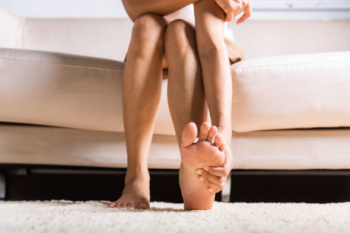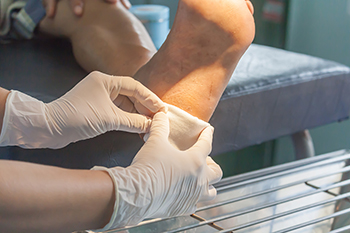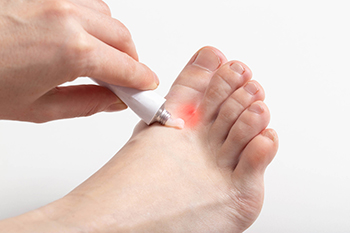Blog

Foot pain can occur in the heel, arch, toes, or ball of the foot and often results from strain, injury, or underlying conditions. Among the most common causes of foot pain are gout in the big toe joint, bunions at the base of the big toe, or hammer toes, where the toes bend into a claw-like position. Having flat feet may place added stress on ligaments in the arch, while plantar fasciitis and heel spurs often create persistent heel pain. Sports injuries, sprains, tendon or ligament tears, and stress fractures can also lead to discomfort and limit mobility. Nerve-related issues, such as Morton’s neuroma or nerve damage linked to diabetes, may cause tingling, burning, or numbness in the feet. A podiatrist can assess the cause of your foot pain and provide appropriate treatment, which may include orthotics, medication, or surgery. If you are experiencing foot pain, it is suggested that you make an appointment with a podiatrist for a diagnosis and treatment options.
Foot Pain
Foot pain can be extremely painful and debilitating. If you have a foot pain, consult with Christian Smith, DPM from UTOEpia Foot and Ankle Specialist. Our doctor will assess your condition and provide you with quality foot and ankle treatment.
Causes
Foot pain is a very broad condition that could be caused by one or more ailments. The most common include:
- Bunions
- Hammertoes
- Plantar Fasciitis
- Bone Spurs
- Corns
- Tarsal Tunnel Syndrome
- Ingrown Toenails
- Arthritis (such as Gout, Rheumatoid, and Osteoarthritis)
- Flat Feet
- Injury (from stress fractures, broken toe, foot, ankle, Achilles tendon ruptures, and sprains)
- And more
Diagnosis
To figure out the cause of foot pain, podiatrists utilize several different methods. This can range from simple visual inspections and sensation tests to X-rays and MRI scans. Prior medical history, family medical history, and any recent physical traumatic events will all be taken into consideration for a proper diagnosis.
Treatment
Treatment depends upon the cause of the foot pain. Whether it is resting, staying off the foot, or having surgery; podiatrists have a number of treatment options available for foot pain.
If you have any questions, please feel free to contact our office located in Memphis, TN . We offer the newest diagnostic and treatment technologies for all your foot care needs.

Diabetic foot wounds can develop when nerve damage causes people to miss signs of pressure, cuts, or irritation on their feet. Poor circulation makes it harder for these wounds to heal, which increases the risk of infection. Wounds often appear on the toes, soles, or heels, especially in spots where shoes rub or pressure builds up from calluses or foot deformities. Because many people with diabetes do not feel pain in their feet, these wounds may go unnoticed and become worse, over time. A podiatrist can examine the wound, check blood flow, test for nerve damage, and provide care to prevent further injury. They can also help reduce pressure on the wound by recommending special footwear or in some cases, surgery. Without proper care, diabetic foot wounds can lead to serious infections and tissue or limb loss. If you notice foot or lower leg wounds that are not healing properly, it is suggested that you schedule an appointment with a podiatrist for safe and effective wound care.
Wound care is an important part in dealing with diabetes. If you have diabetes and a foot wound or would like more information about wound care for diabetics, consult with Christian Smith, DPM from UTOEpia Foot and Ankle Specialist. Our doctor will assess your condition and provide you with quality foot and ankle treatment.
What Is Wound Care?
Wound care is the practice of taking proper care of a wound. This can range from the smallest to the largest of wounds. While everyone can benefit from proper wound care, it is much more important for diabetics. Diabetics often suffer from poor blood circulation which causes wounds to heal much slower than they would in a non-diabetic.
What Is the Importance of Wound Care?
While it may not seem apparent with small ulcers on the foot, for diabetics, any size ulcer can become infected. Diabetics often also suffer from neuropathy, or nerve loss. This means they might not even feel when they have an ulcer on their foot. If the wound becomes severely infected, amputation may be necessary. Therefore, it is of the upmost importance to properly care for any and all foot wounds.
How to Care for Wounds
The best way to care for foot wounds is to prevent them. For diabetics, this means daily inspections of the feet for any signs of abnormalities or ulcers. It is also recommended to see a podiatrist several times a year for a foot inspection. If you do have an ulcer, run the wound under water to clear dirt from the wound; then apply antibiotic ointment to the wound and cover with a bandage. Bandages should be changed daily and keeping pressure off the wound is smart. It is advised to see a podiatrist, who can keep an eye on it.
If you have any questions please contact our office located in Memphis, TN . We offer the newest diagnostic and treatment technologies for all your foot and ankle needs.

Step with assurance, thanks to enhanced ankle stability from orthotics! If you're active and on the move, Custom Orthotics are your ally for stronger, steadier ankles. They align your foot and ankle, reducing the risk of sprains and offering solid support for every stride. Don’t let instability hold you back. Try Custom Orthotics from our office, and discover unshakable confidence in every step!

Athlete's foot is a fungal infection that affects the feet, particularly the soles and the spaces between the toes. Symptoms include scaling, which can vary from mild redness and itching, to severe cracking and painful blisters. As the athlete's foot infection progresses, the skin may become thickened, and, in some cases, it can lead to bacterial infections, especially in older adults or those with poor circulation. The fungus thrives in moist, warm environments, such as communal showers or areas where individuals walk barefoot. Wearing tight shoes can also increase the risk. Diagnosis is typically made through a visual examination, though a skin scraping may be taken for further analysis, if needed. A podiatrist can provide effective treatment with antifungal medications applied to the affected area or taken orally in more severe cases. If you have a stubborn athlete's foot infection, it is suggested that you schedule an appointment with a podiatrist for advanced treatment.
Athlete’s Foot
Athlete’s foot is often an uncomfortable condition to experience. Thankfully, podiatrists specialize in treating athlete’s foot and offer the best treatment options. If you have any questions about athlete’s foot, consult with Christian Smith, DPM from UTOEpia Foot and Ankle Specialist. Our doctor will assess your condition and provide you with quality treatment.
What Is Athlete’s Foot?
Tinea pedis, more commonly known as athlete’s foot, is a non-serious and common fungal infection of the foot. Athlete’s foot is contagious and can be contracted by touching someone who has it or infected surfaces. The most common places contaminated by it are public showers, locker rooms, and swimming pools. Once contracted, it grows on feet that are left inside moist, dark, and warm shoes and socks.
Prevention
The most effective ways to prevent athlete’s foot include:
- Thoroughly washing and drying feet
- Avoid going barefoot in locker rooms and public showers
- Using shower shoes in public showers
- Wearing socks that allow the feet to breathe
- Changing socks and shoes frequently if you sweat a lot
Symptoms
Athlete’s foot initially occurs as a rash between the toes. However, if left undiagnosed, it can spread to the sides and bottom of the feet, toenails, and if touched by hand, the hands themselves. Symptoms include:
- Redness
- Burning
- Itching
- Scaly and peeling skin
Diagnosis and Treatment
Diagnosis is quick and easy. Skin samples will be taken and either viewed under a microscope or sent to a lab for testing. Sometimes, a podiatrist can diagnose it based on simply looking at it. Once confirmed, treatment options include oral and topical antifungal medications.
If you have any questions, please feel free to contact our office located in Memphis, TN . We offer the newest diagnostic and treatment technologies for all your foot care needs.
